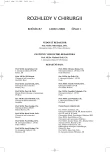Polytraumas in Injured Patients over 65 Years of Age
Authors:
F. Vyhnánek 1; M. Fric 3; V. Ducháč 2; J. Pažout 3; P. Waldauf 3; P. Skála 2; V. Teplan jr. 2
Authors‘ workplace:
Traumatologické centrum FNKV, vedoucí lékař: doc. MUDr. F. Vyhnánek, CSc.
1; Chirurgická klinika FNKV a 3. LF UK, přednosta: doc. MUDr. J. Fanta, DrSc.
2; Klinika anesteziologie a resuscitace FN KV a 3. LF UK Praha, přednosta: prof. MUDr. J. Páchl, CSc.
3
Published in:
Rozhl. Chir., 2008, roč. 87, č. 1, s. 46-49.
Category:
Monothematic special - Original
Overview
Introduction:
Geriatric trauma is most commonly defined as a trauma in patients of 65 years of age and over. These patients represent a specific problem due to their vulnerability, limited physiological response to the traumatic stress and high frequency of associated disorders, complicating the treatment. The aim of this report is to assess polytrauma patients of 65 years of age and older, compared to a group of younger patients.
Patients, Methodology and Results:
198 polytrauma patients, hospitalized from 2005 to 2006 were included in the retrospective study. Out of the total, 27 subjects (13.6%) were 65 + years old. Upon their admission, the difference in APACHE II between the groups was highly statistically significant (19–27.2, p = 0.0001). The ISS (the mean value) score was higher in the elderly patients (29–38). Traffic injuries, including pedestrian-vehicle collisions (61–73 %), were the commonest mechanism of injuries in the both groups. There was a significant difference in the rates of craniocerebral injuries (80–96 %, p=0.041). During the early posttraumatic period, 99 (57%) urgent surgical procedures were performed in younger patients, compared to 11 (79%) procedures in the elderly. The difference in death rates was statistically significant (25–44 %, p = 0.031).
Conclusion:
Polytraumas in the elderly (65 years of age and over) injured is characterized by higher severity scores and higher rates of craniocerebral injuries. Traffic injury was the commonest mechanism of injury. The death rate was higher in the elderly patients.
Key words:
polytrauma – injured patients of 65 years of age and over – incidence – treatment
Sources
l. Aldrian, S., Koenig, F., Weninger, P., Vécsei, V., Nau, T. Characteristics of polytrauma patiens between 1992 and 2002: what is changing? Injury, 2007, 38, s. 1059–1064.
2. Aldrian, S., Nau, T., Koenig, F., Véscei, V. Geriatric polytrauma. Wien Klin. Wochenschr., 2005, 117, s. 145–149.
3. Hannan, E. X., Waller, Ch. H., Farrell, L..S., Rosati, C. Elderly trauma inpatients in New York state: 1994–1998. J. Trauma, 2004, 56, s. 1297–1304.
4. Chang, T. T., Schecter, W. P. Injury in the elderly and end-of-life decisions. Surg. Clin. North Am., 2007, 87, s. 229–246.
5. Kauder, D. R., Schwab, C. W., Shapiro, M. B. Geriatric trauma: patterns, care, and outcomes. In: Moore, E. E., Feliciano, D. V., Mattox, K. L.: Trauma. McGraw-Hill, NewYork, 2004, s. 1041–1055.
6. Knudson, M. M., Lieberman, J., Morfia, J. A. Jr., et al. Mortality factors in geriatric blunt trauma patients. Arch. Surg., 1994, 129, s. 448–453.
7. Lonner, J. H., Koval, K. J. Polytrauma in the elderly. Clin. Orthop. Relat. Res., 1995, 318, s. 136–143.
8. Mandavia, D., Newton, J. Geriatric trauma. Emerg. Med. Clin. North Am., 1998, 16, s. 257–274.
9. McGwin, G. Jr., Mac Lennan, P. A., Fife, J. B., Davis, G. G., Rue, L. W. Preexisting conditions and mortality in older trauma patients. J. Trauma, 2004, 56, s. 1291–1298.
10. McMahon, D. J., Shapiro, M. B., Kauter, D. R. The injured elderly in the trauma intensive care unit. Surg. Clin. North Am., 2000, 80, s. 10005–10021.
11. Zehtabchi, S., Baron, B. J. Utility of base deficit for identifying major injury in elder trauma patients. Acad. Emerg. Med., 2007, 14, s. 829–831.
Labels
Surgery Orthopaedics Trauma surgeryArticle was published in
Perspectives in Surgery

2008 Issue 1
Most read in this issue
- New Options for Management of Posttraumatic Articular Cartilage Defects
- K-ras Mutation as a Prognostic Factor in Colorectal Carcinoma
- Diagnostics of Intestinal Ischemia. Influence of Surgery on Plasma Levels of I-FABP as the Marker of Enterocyte Injury
- Variations of Primary Spontaneous Pneumothorax Management
